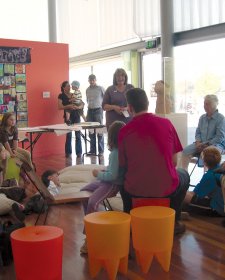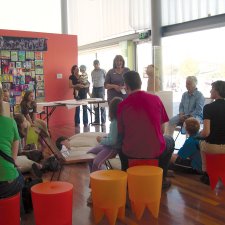Her Excellency Marjorie Jackson-Nelson ac cvo mbe (b. 1931), former sprinter, has been Governor of South Australia since November 2001. The ‘Lithgow Flash’ won two Olympic gold medals at Helsinki in 1952, becoming the first Australian woman to win an Olympic gold medal for track and field and the first Australian to win an Olympic gold medal on the running track since 1896.
Between 1950 and 1954 she won every State and Australian title for the 100 yards, 100 metres, 220 yards and 200 metre sprints. She broke world sprint records on ten occasions and garnered seven Commonwealth Games gold medals. Sportsman of the Year in 1952, in 1953 she was awarded an mbe for her services to athletics.
Since the death from leukaemia in 1977 of her husband, Peter Nelson, she has been dedicated to securing funds to sponsor research into the disease, raising several million dollars for facilities in Adelaide. In 1988, she was one of only 20 living figures on the list of the Australian Bicentenary Committee’s ‘200 Great Australians’. Jackson-Nelson became a Companion of the Order of Australia in 2001; she was appointed a Commander of the Royal Victorian Order by HM Queen Elizabeth II during the Royal visit to Adelaide in February 2002.
Avril Thomas was commissioned to undertake the portrait of the Governor after her portrait of South Australian mp and Minister for Foreign Affairs Alexander Downer was a finalist in the 2005 Archibald Prize. A nurse by profession, Thomas has built up a successful portrait practice over the past decade, completing more than 50 commissions to date.
Thomas painted the Governor in a number of sittings at Government House, completing some details from photographs. Included in the portrait are items referring to Jackson-Nelson’s Olympic career, and to her current position. Her kangaroo-skin running spikes lie on the table beside her. On the larger table is a favourite photograph of her grandchildren; two other photographs show the Duke of Edinburgh congratulating her after her Olympic win, and her showing off her medal.
The torch is from the 2000 Sydney Olympics, and the figure is a maquette of the bronze life-sized statue of her in her home town of Lithgow. Two exterior details demonstrate the portraitist’s prerogative of adapting the real to encapsulate a mood or exploit her own skills. The view is of the sweeping drive to the front door of Government House from the west – not the outlook from the room in which the sitter is depicted, but chosen by the artist to emphasise Her Excellency’s role. Similarly, the garden beds that had been in full bloom when Thomas first saw them were tilled bare at the time of the portrait sittings, so they were painted from photographs supplied by the gardening staff. When not working on commissions, Thomas often paints flower pictures.
The Governor is in a formal pose appropriate to her station. The hotpink outfit she wears is one of three that the artist and sitter considered together. Thomas found that it complements her ‘wonderful sparkle’ and vibrancy and provides a striking contrast to her ‘extraordinary’ blue eyes. The shoes she wears the artist considers ‘simply smashing’. ‘I like having the two pairs of shoes in the painting ... different kinds of spikes, representing then and now,’ she comments.
The Governor and her staff were all interested in seeing the developing image and during the hours of painting in the morning room and in the garden they dropped by to see how it was progressing. Thomas says that the ‘fantastic thing about portraiture is being able to meet wonderful people, getting a small glimpse into someone’s life … With this portrait I was struck by the respect, admiration and fondness people have for Her Excellency. She is truly a remarkable person; her strength and warmth is an inspiration.’
The portrait was unveiled on 21 November 2006 at Government House, Adelaide.















